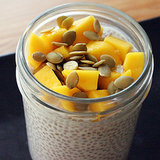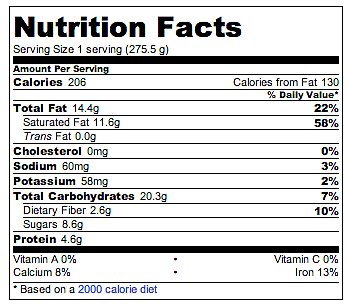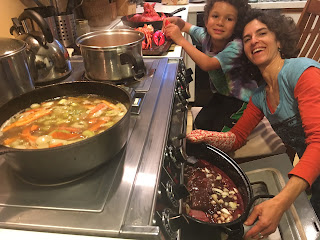YUMMY TUMMY LOVE
This is so delicious!
This is so darn good, I had to share. I indulged on my first chia pudding after buying a large cup of it at RAW BOB'S ORGANIC JUICERY in East Greenwich. It was $8.95 and worth every penny and mmm mmm goodness. Splurging on my tummy was yummy!
Chia seed's super power:
- perfect ratio of protein, healthy carbs, fat and soluble fiber (soluble fiber helps move bowels)
- high in essential fatty acids (omega 3 and omega 6's - in a healthy proportion*)
- great source of iron, calcium and zinc
Vanilla Chia Pudding
Ingredients: 
Topping Suggestions:
Directions:
Ingredients: This recipe includes 1/4 cup of diced mango and pepita (pumpkin) seeds, but feel free to top the pudding with your favorite fruit and nuts. Papaya helps with digestion of proteins if a big dinner the night before is stuck, the chia and papaya will help.

Source: Calorie Counter

- 1 cup unsweetened almond milk (homemade or purchased, refrigerated almond milk)
- 1/2 cup canned, full-fat coconut milk (from can)
- 1/2 teaspoon pure vanilla
- 1/2 teaspoon ground cinnamon
- 1/4 cup chia seeds
- liquid stevia - start with 2 drops and add to taste
- (OR) 1 -2 tsp of organic coconut nectar (blonde)
- NOTE: if having for breakfast you do not want to create a dessert.
- Sugar in the morning will slow your metabolism, and make you crave sweets and floured carbs all day. Go mellow and enjoy with a little vanilla and cinnamon if an AM starter.
Topping Suggestions:
- Fresh blueberries
- Additional coconut milk
- Toasted coconut
- Toasted pecans
- Fresh raspberries (my fave)
Directions:
- In a medium bowl whisk together almond milk, 1/2 cup coconut milk, liquid stevia, vanilla and cinnamon. Add chia seeds; whisk to combine. Let stand at room temperature for 20 minutes, whisking occasionally to distribute chia seeds.
- Once the chia seeds have absorbed the liquid and the mixture has thickened, spoon the chia pudding into 4 small glasses. Cover and refrigerate at least 1 hour to thicken the pudding. (The pudding can be stored in the fridge up to 2 days.) Enjoy!
Mango Chia Pudding
Ingredients: This recipe includes 1/4 cup of diced mango and pepita (pumpkin) seeds, but feel free to top the pudding with your favorite fruit and nuts. Papaya helps with digestion of proteins if a big dinner the night before is stuck, the chia and papaya will help.

INGREDIENTS
1/4 cup chia seeds
1 cup light or full-fat coconut milk, depending on preference
1/2 tablespoon blonde coconut nectar or honey (if not for breakfast) Remember not to have dessert for breakfast: sweet sugar will make you store fat all day, instead of burn it. Keep as a healthy breakfast by not sweetening the beneficial coconut and chia seed fat that will burn as fuel when no sugar is around. Add the savory seeds and a little fresh, fibrous fruit with it's water and fiber for a touch of bright sweet fun.
1 cup light or full-fat coconut milk, depending on preference
1/2 tablespoon blonde coconut nectar or honey (if not for breakfast) Remember not to have dessert for breakfast: sweet sugar will make you store fat all day, instead of burn it. Keep as a healthy breakfast by not sweetening the beneficial coconut and chia seed fat that will burn as fuel when no sugar is around. Add the savory seeds and a little fresh, fibrous fruit with it's water and fiber for a touch of bright sweet fun.
DIRECTIONS
- Mix chia seeds, coconut milk, and honey together in a small bowl or glass mason jar. Let it set in refrigerator overnight.
- Remove it from the fridge, and make sure your pudding looks thick and the chia seeds have gelled. Top with fresh fruit and nuts, and enjoy immediately.
Source: Calorie Counter
INFORMATION
- Category
- Desserts
- Yield
- 1 serving
NUTRITION
- Calories per serving
- 206
MORE ON CHIA's OMEGA-3 ESSENTIAL FATTY ACID RATIOS VS. OTHER PUFA OILS:
- Several sources of information suggest that human beings evolved on a diet with a ratio of omega-6 to omega-3 essential fatty acids (EFA) of approximately 1/1 (plant source oils to fish source oils)
Today in Western diets the ratio is 15/1-16.7/1. (Thanks to the addictive flavoring agent put in the recipe of all fast food french fries, and the amazing goodness of fried calamari) Excessive amounts of omega-6 polyunsaturated fatty acids (PUFA's like soy, corn, safflower, canola and peanut oils) and a very high omega-6/omega-3 ratio, promote the pathogenesis of many diseases, including cardiovascular disease, cancer, and inflammatory and autoimmune diseases, whereas increased levels of omega-3 PUFA (chia, flax, hemp, kiwi fruit seeds, wild salmon, sardines) (a low omega-6/omega-3 ratio) exert suppressive effects. In the secondary prevention of cardiovascular disease, a ratio of 4/1 was associated with a 70% decrease in total mortality. A ratio of 2.5/1 reduced rectal cell proliferation in patients with colorectal cancer, whereas a ratio of 4/1 with the same amount of omega-3 PUFA had no effect. The lower omega-6/omega-3 ratio in women with breast cancer was associated with decreased risk. A ratio of 2-3/1 suppressed inflammation in patients with rheumatoid arthritis A ratio of 5/1 had a beneficial effect on patients with asthma, where as a ratio of 10/1 had adverse consequences.- These studies indicate that the optimal ratio may vary with the disease under consideration. This is consistent with the fact that chronic diseases are multigenic and multifactorial.
- Therefore, it is quite possible that the therapeutic dose of omega-3 fatty acids will depend on the degree of severity of disease resulting from the genetic predisposition.
- A lower ratio of omega-6/omega-3 fatty acids is more desirable in reducing the risk of many of the chronic diseases of high prevalence in Western societies, as well as in the developing countries, that are being exported to the rest of the world.
 from POPSUGARFITNESS SITE
from POPSUGARFITNESS SITE

Comments
Bài pốt của Ad rất hay, thanks anh đã share.
Trang tham khảo : tập Yoga tại nhà